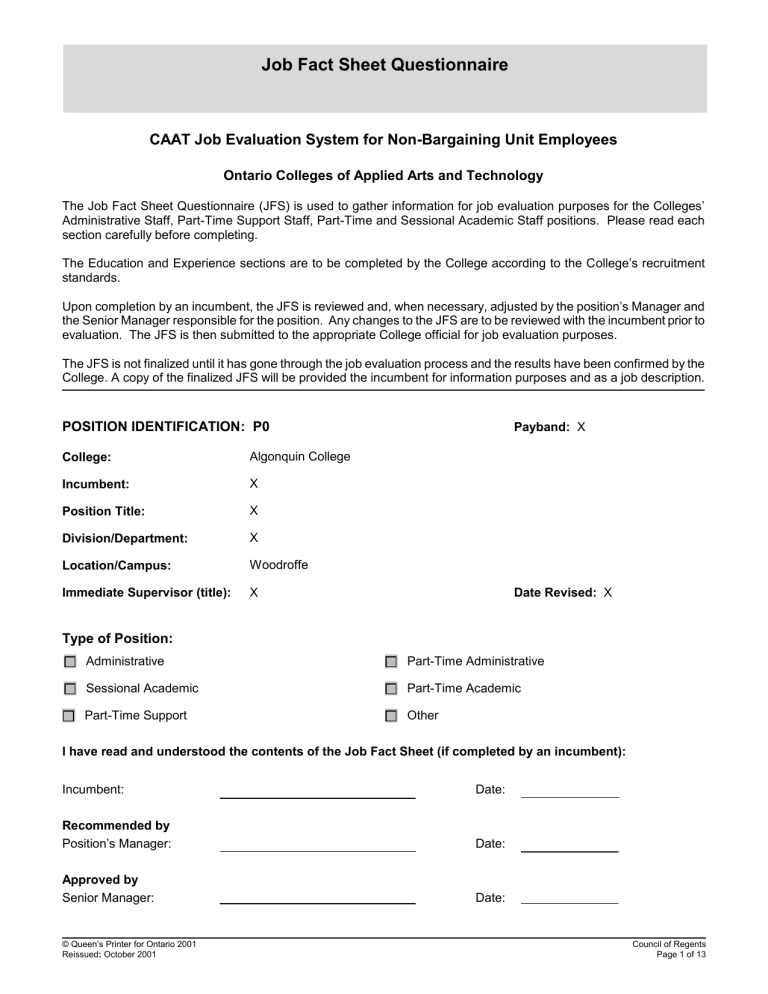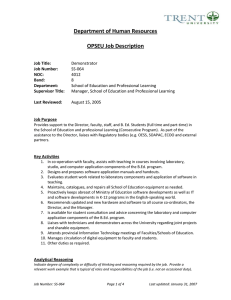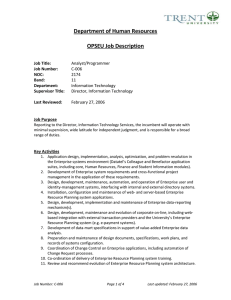
Position Title: Position # Job Fact Sheet Questionnaire CAAT Job Evaluation System for Non-Bargaining Unit Employees Ontario Colleges of Applied Arts and Technology The Job Fact Sheet Questionnaire (JFS) is used to gather information for job evaluation purposes for the Colleges’ Administrative Staff, Part-Time Support Staff, Part-Time and Sessional Academic Staff positions. Please read each section carefully before completing. The Education and Experience sections are to be completed by the College according to the College’s recruitment standards. Upon completion by an incumbent, the JFS is reviewed and, when necessary, adjusted by the position’s Manager and the Senior Manager responsible for the position. Any changes to the JFS are to be reviewed with the incumbent prior to evaluation. The JFS is then submitted to the appropriate College official for job evaluation purposes. The JFS is not finalized until it has gone through the job evaluation process and the results have been confirmed by the College. A copy of the finalized JFS will be provided the incumbent for information purposes and as a job description. POSITION IDENTIFICATION: P0 College: Algonquin College Incumbent: X Position Title: X Division/Department: X Location/Campus: Woodroffe Immediate Supervisor (title): X Payband: X Date Revised: X Type of Position: Administrative Part-Time Administrative Sessional Academic Part-Time Academic Part-Time Support Other I have read and understood the contents of the Job Fact Sheet (if completed by an incumbent): Incumbent: Date: Recommended by Position’s Manager: Date: Approved by Senior Manager: Date: © Queen’s Printer for Ontario 2001 Reissued: October 2001 Council of Regents Page 1 of 13 Position Title: Position # Job Fact Sheet Questionnaire POSITION SUMMARY Provide a concise description of the position by identifying its most significant responsibilities and/or accountabilities. KEY DUTIES Provide a description of the position’s key duties. Estimate the percentage of time spent on each duty (to the nearest 5%). Add an extra page if necessary. KEY DUTIES % OF TIME 1. (50%) 2. ( %) ( %) ( %) ( %) ( %) ( %) ( %) ( %) 3. 4. 5. 6. 7. 8. 9. TOTAL: © Queen’s Printer for Ontario 2001 Reissued: October 2001 100% Council of Regents Page 2 of 13 Position Title: 1. Position # Job Fact Sheet Questionnaire COMPLEXITY - JUDGEMENT (DECISION MAKING) Complexity refers to the variety and relative difficulty of comprehending and critically analyzing the material, information, situations and/or processes upon which decisions are based. Judgement refers to the process of identifying and reviewing the available options involved in decision making and then choosing the most appropriate option. Judgement involves the application of the knowledge and experience expected of an individual performing the position. Provide up to three examples of the most important and difficult decisions that an incumbent is typically required to make. a) b) c) d) © Queen’s Printer for Ontario 2001 Reissued: October 2001 Council of Regents Page 3 of 13 Position Title: 2. Position # Job Fact Sheet Questionnaire EDUCATION (to be completed by the College) Education refers to the minimum level of formal education and/or the type of training or its equivalent that is required of an incumbent at the point of hire for the position. This may or may not match an incumbent’s actual education or training. The College is to identify the minimum level of education and/or type of training or its equivalent that is required for the position based upon the College’s recruitment standards. Non-Post Secondary Partial Secondary School Secondary School Completion Post Secondary 1-Year Certificate 4-Year Degree 2-Year Diploma Masters Degree 3-Year Diploma/Degree Post Graduate Degree Professional Designation Specify: Other Specify: A) Specify and describe any program speciality, certification or professional designation necessary to fulfil the requirements of the position. B) Specify and describe any special skills or type of training necessary to fulfil the requirements of the position (e.g., computer software, client service skills, conflict resolution, operating equipment). © Queen’s Printer for Ontario 2001 Reissued: October 2001 Council of Regents Page 4 of 13 Position Title: 3. Position # Job Fact Sheet Questionnaire EXPERIENCE (to be completed by the College) Experience refers to the amount of related, progressive work experience required to obtain the essential techniques, skills and abilities necessary to fulfil the requirements of the job at the point of hire into the position. This may or may not match the incumbent’s actual amount of experience. The College is to identify the minimum amount and type of experience appropriate for the position based upon the College’s recruitment requirements. Experience required at the point of hire. Up to and including: 0 - no experience 5 years 3 months 7 years 6 months 9 years 1 year 11 years 18 months 13 years 2 years 15 years 3 years 17 years 4 years Specify and describe any specialized type of work experience necessary to fulfill the requirements of the position. © Queen’s Printer for Ontario 2001 Reissued: October 2001 Council of Regents Page 5 of 13 Position Title: 4. Position # Job Fact Sheet Questionnaire INITIATIVE - INDEPENDENCE OF ACTION Initiative - Independence of action refers to the amount of responsibility inherent in a position and the degree of freedom that an incumbent has to initiate or take action to complete the requirements of the position. An incumbent is required to foresee activities and decisions to be made, then take the appropriate action(s) to ensure successful outcomes. This factor recognizes the established levels of authority which may restrict the incumbent’s ability to initiate or take action, e.g., obtaining direction or approval from a supervisor, reliance on established procedures/methods of operation or professional practices/standards, and/or built-in-controls dictated by computer/ management systems. A) Briefly describe up to three typical job duties/types of decisions that the incumbent is required to perform using their initiative without first having to obtain direction or approval from a supervisor. a) b) c) d) B) Briefly describe up to three typical job duties/types of decisions that the incumbent is required to perform which required the direction or approval from a supervisor. a) b) c) d) Give specific examples of guidelines, procedures, manuals (formal or informal), computer systems/programs that are used in performing job duties and in making decisions, e.g., Government regulations, professional or trade standards, College policies or procedures, department or program procedures, computerized/manual programs/systems and any other defined methods or procedures. © Queen’s Printer for Ontario 2001 Reissued: October 2001 Council of Regents Page 6 of 13 Position Title: 5. Position # Job Fact Sheet Questionnaire POTENTIAL IMPACT OF DECISIONS Potential Impact of Decisions recognizes the potential consequences that errors in judgement made by an incumbent, despite due care, could have on the College. Usually, the higher the level of accountability inherent in a position, the greater the potential consequences there are on the College from errors in judgement. Give up to three examples of the typical types of errors in judgement that an incumbent could make in performing the requirements of the position. Do not describe errors which could occur as a result of poor performance, or ones that are rare or extreme. Indicate the probable effects of those errors on the College, e.g., loss of reputation of program/College, waste of resources, financial losses, injury, property damage, affects on staff, students, clients or public. a) b) c) d) © Queen’s Printer for Ontario 2001 Reissued: October 2001 Council of Regents Page 7 of 13 Position Title: 6. Position # Job Fact Sheet Questionnaire CONTACTS AND WORKING RELATIONSHIPS Contacts and Working Relationships refers to the types, importance and intended outcomes of the contacts and working relationships required by an incumbent to perform the responsibilities of a position. It also measures the skill level required to be effective in dealing with contacts and being involved in working relationships. This factor does not focus on the level of the contact, but on the nature of the contact. Indicate by job title, with whom an incumbent is required to interact to perform the duties and responsibilities of the positions. Describe the nature, purpose and frequency of the interaction, e.g., exchanging information, teaching, conflict resolution, team consultation, counselling. Contacts Contacts by Job Title Nature and Purpose of Contact Internal to the College: Frequency of Contact Occasional Frequent Internal to the college, e.g. students, staff, senior management, colleagues. External to the College: Occasional Frequent External to the college, e.g. suppliers, advisory committees, staff at other colleges, government, public/private sector. Occasional Frequent (O) (F) © Queen’s Printer for Ontario 2001 Reissued: October 2001 Contacts are made once in a while over a period of time. Contacts are made repeatedly and often over a period of time. Council of Regents Page 8 of 13 Position Title: 7a. Position # Job Fact Sheet Questionnaire CHARACTER OF SUPERVISION/FUNCTIONAL GUIDANCE Character of Supervision identifies the degree and type of supervisory responsibility in a position or the nature of functional/program supervision, technical direction or advice involved in staff relationships. () Check the applicable box(es) to describe the type of supervisory responsibility required by an incumbent in the position: Not responsible for supervising or providing guidance to anyone. Provides technical and/or functional guidance to staff and/or students. Instructs students and supervises various learning environments. Assigns and checks work of others doing similar work. Supervises a work group. Assigns work to be done, methods to be used, and is responsible for the work performed by the group. Manages the staff and operations of a program area/department.* Manages the staff and operations of a division/major department.* Manages the staff and operations of several divisions/major departments.* Acts as a consultant to College management. Other e.g., counselling, coaching. Please specify: * Includes management responsibilities for hiring, assignment of duties and work to be performed, performance management, and recommending the termination of staff. Specify staff (by title) or groups who are supervised/given functional guidance by an incumbent. © Queen’s Printer for Ontario 2001 Reissued: October 2001 Council of Regents Page 9 of 13 Position Title: 7b. Position # Job Fact Sheet Questionnaire SPAN OF CONTROL Span of Control is complementary to Character of Supervision/Functional Guidance. Span of Control refers to the total number of staff for which the position has supervisory responsibility, (i.e., subordinates, plus all staff reporting to these subordinates). Enter the total number of full time and full time equivalent staff reporting through to the position. Also identify the number of staff for whom the position has indirect responsibility (contract for service), if applicable. Type of Staff Number of Staff Full-Time Staff Non Full Time Staff (FTE) * Contract for Service ** Total: * Full Time Equivalency (FTE) conversions for non full time staff are as follows: Academic Staff Identify the total average annual teaching hours taught by all non full time teachers (part-time, partial load and sessional) for which the position is accountable and divide by 648 hours for post secondary teachers and 760 hours for non-post secondary teachers. Support Staff Identify the total average annual hours worked by part-time support staff for which the position is accountable and divide by 1820 hours. Administrative Staff Identify the total average annual hours worked by non full time administrative staff for which the position is accountable and divide by 1820 hours. ** Contract for Services When considering “contracts for services,” review the nature of the contractual arrangements to determine the degree of “supervisory” responsibility the position has for contract employees. This could range from “no credit for supervising staff” when the contracting company takes full responsibility for all staffing issues to “prorated credit for supervising staff” when the position is required to handle the initial step(s) when contract staffing issues arise. © Queen’s Printer for Ontario 2001 Reissued: October 2001 Council of Regents Page 10 of 13 Position Title: 8. Position # Job Fact Sheet Questionnaire PHYSICAL AND SENSORY DEMANDS Physical/Sensory Demands considers the degree and severity of exertion associated with the position. The factor considers the intensity and severity of the physical effort rather than the strength or energy needed to perform the task. It also considers the sensory attention required by the job as well as the frequency of that effort and the length of time spent on tasks that cause sensory fatigue. Identify the types of physical and/or sensory demands that are required by an incumbent. Indicate the frequency of the physical demands as well as the frequency and duration of the sensory demands. Use the frequency and duration definitions following the tables to assist with the descriptions. PHYSICAL DEMANDS Describe the types of activities and provide examples that demonstrate the physical effort that is required in the position on a regular basis, i.e., sitting, standing, walking, climbing, lifting and/or carrying light, medium or heavy objects, pushing, pulling, working in an awkward position or maintaining one position for a long period of time. Types of Activities that Demonstrate Physical Effort Required Frequency (note definitions below) Occasional Moderate Considerable Extended Continuous SENSORY DEMANDS Describe the types of activities and provide examples that demonstrate the sensory effort that is required in the position on a concentrated basis, i.e., reading information/data without interruption, inputting data, report writing, operating a computer or calculator, fine electrical or mechanical work, taking minutes of meetings, counselling, tasting, smelling etc. Frequency (note definitions below) Types of Activities that Demonstrate Sensory Effort Required © Queen’s Printer for Ontario 2001 Reissued: October 2001 Occasional Moderate Considerable Extended Duration Continuous Short Intermediate or Long Council of Regents Page 11 of 13 Position Title: Position # Job Fact Sheet Questionnaire FREQUENCY: Occasional: Occurs once in a while, sporadically. Moderate: Occurs on a regular, ongoing basis for up to a quarter of the work period. Considerable: Occurs on a regular, ongoing basis for up to a half of the work period. Extended: Occurs on a regular, ongoing basis for up to three-quarters of the work period. Continuous: Occurs on a regular, ongoing basis throughout the entire work period except for regulated breaks. DURATION: 9. Short: Up to one hour at a time without the opportunity to change to another task or take a break. Intermediate: More than one hour and up to two hours at a time without the opportunity to change to another task or take a break. Long: More than two hours at a time without the opportunity to change to another task or take a break. WORKING CONDITIONS Working Conditions considers the frequency and type of exposure to undesirable, disagreeable environmental conditions or hazards, under which the work is performed. Describe any unpleasant environmental conditions and work hazards that the incumbent is exposed to during the performance of the job. Environment Describe the types of activities and provide examples that demonstrate exposure to unpleasant environmental conditions in the day-to-day activities that are required in the job on a regular basis, e.g., exposure to dirt, chemical substances, grease, extreme temperatures, odours, noise, travel, verbal abuse, body fluid, etc. Indicate the activity as well as the frequency of exposure to undesirable working conditions. Types of Activities That Involve Job Related Unpleasant Environmental Conditions © Queen’s Printer for Ontario 2001 Reissued: October 2001 Frequency Occasional (note definitions below) Frequent Continuous Council of Regents Page 12 of 13 Position Title: Position # Job Fact Sheet Questionnaire Hazards Describe the types of activities and provide examples that demonstrate the hazards in the dayto-day activities that are required in the job on a regular basis, e.g. chemical substance, electrical shocks, acids, noise, exposure to infectious disease, violence, body fluids, etc. Indicate the activity as well as the frequency of exposure to hazards. Frequency (note definitions below) Types of Activities That Involve Job Related Hazards Occasional Frequent Continuous Frequency: Occasional Occurs once in a while, sporadically. Frequent Occurs regularly throughout the work period. Continuous Occurs regularly, on an ongoing basis, throughout most of the work period. Additional Notes Pertaining to this Position: Please save form in the following format: “Position Title – Department – Incumbent”. Please note formatting errors will be corrected if necessary. To cursor from one entry point to the next please use the arrow keys or Tab. © Queen’s Printer for Ontario 2001 Reissued: October 2001 Council of Regents Page 13 of 13


